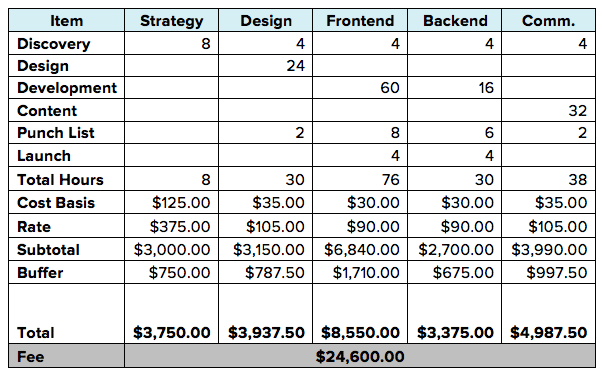The services you receive from a digital marketing agency vary for different accounts and projects, thus the compensation structure can vary as well. Agencies have their own ways of doing things, but a few standards tend to remain the norm. Either way, prepare yourself for all possible payment structures.
In this article, I’ll explore the three most common agency fee structures:
- Standard retainers
- Commission compensation
- Billable hours or itemized breakdowns (project-based fees)
STANDING RETAINERS
The most common model for digital marketing agencies is a monthly retainer for ongoing services like social media marketing, search engine optimization, and content marketing. This recurring retainer is agreed upon when the contract is signed and remains in effect for the duration of the agreement (typically 6-12 months).
Maintaining a marketing campaign month-to-month often requires a similar bank of work hours each month, therefore, the standing price is maintained throughout the year. Additional services, campaigns, or projects are treated as separate or add-on fees. Marketing a medical practice online, whether with search, social, content or a combination of the three, requires diligence, commitment and patience. Clients who want to sign anything less than a three-month contract typically don’t have the patience (or trust) to commit long enough for the agency to prove results, which is usually six months.
PRO TIP: A standard retainer is the agency’s way of spreading out the cost incurred to the client over time, especially the setup fees in the beginning of a campaign or marketing program. For example, since many marketing programs take a considerable amount of time in their infancy, there’s no way a client would pay $16,000 in the first three months when few results are produced. Instead, the agency stretches that $16,000 over the course of twelve months:
- First 3 months: $16,000
- Months 4-12: $20,000
- Total 12 months: $36,000
- Amortized 12 payments: $3,000
COMMISSION COMPENSATION (E.G. PERCENTAGE SPEND)
The old school model of brand marketing relied heavily on paid advertising and media buys in newspapers, magazines, television, and radio. In this traditional model, it’s common for an agency to charge a management fee based on a percentage of the advertising budget. This commission is often in the range of 10-20% of the total ad spend.
In today’s digital landscape, PPC (Pay-Per-Click) contracts typically fall under the commission compensation structure since they charge based on percentage spent or percentage of profits. A sliding commission serves to adjust for the added work on larger budget spends and less work on smaller initiatives. With modern digital marketing, there is often a large degree of work that does not rely on the extra expenditure of paid ad dollars, so this fee structure is less common for internet-based marketing, especially if your focus is on organic search rankings and social media engagement. Those services are better suited to a standard monthly fee than a percent commission.
PRO TIP: If your agency tries to charge you a commission based on revenue earned, this is fee splitting. It’s ok to charge a commission on revenue spent, not earned (at least in this industry given your a medical facility).
BILLABLE HOURS OR ITEMIZED BREAKDOWNS
Billable hours typically account for additional services outside the scope of your monthly retainer’s work agreement. For example, ongoing technical analysis and platform management will often be accounted for in man-hours, and if you exceed the monthly man-hours as defined in your work agreement, the agency will charge you an hourly rate.
Defined projects like a website, logo design, or piece of blog content can be quantified to a specific price and itemized individually. In the event that you hire an agency to execute certain deliverables on a project-by-project basis, you’ll receive an itemized breakdown when the project is complete outlining your balance due. Agencies differ in how they report the breakdown of your marketing dollars, so ask up front what you can expect to see on your bill. The more detail provided, the more you can scrutinize your ROI throughout the marketing contract.
PRO TIP: Be wary of agencies that try to itemize costs for long term services like search engine optimization, social media marketing, content marketing or website design and development. With so many hours and resources needed to successfully execute any of the above, allowing an agency to bill you hourly for these services relinquishes 100% of the control you have over what you pay (they get to set the hours, even if you set the wage). And it’s always going to be an exorbitant amount.
CONTRACT TERMS
Most marketing teams will need at least 6 months to show solid results in digital marketing. Some agencies structure their contracts around defined campaign periods, while others intend on maintaining a monthly relationship for the foreseeable future and will tend toward yearly contracts for a set monthly fee.
It goes without saying, but you should only sign long term contracts if you’re confident in the agency you’re hiring. If the level of service you receive is not up to par or the results aren’t there, it can be difficult to dissolve the contract. Read thoroughly before you sign and understand your options for exiting the agreement if your terms are not met.
Last, familiarize yourself with the agency’s cancellation policy just in case something goes horribly wrong six months before your contract expires. Stay away from an agency that forces you to buy out your contract value if you cancel; this is usually a bad sign.




